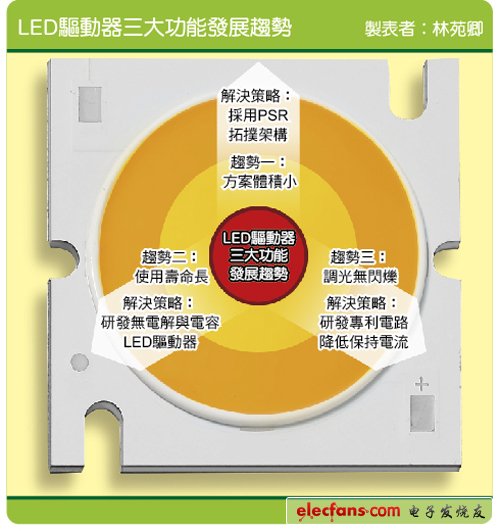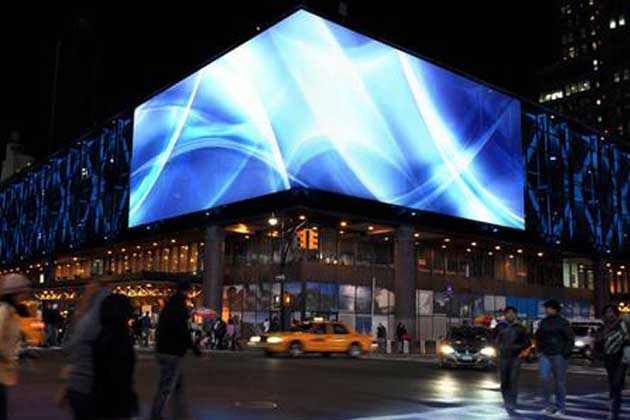Matching traditional TRIAC and non-electrolytic, capacitive LED drivers will be popular. Under the innovation of LED driver design, the defects of LED driver supporting TRIAC dimming and short life have been greatly improved, which is expected to increase the added value of LED lamps and accelerate market penetration. Flicker-free and electrolysis-free, capacitive light-emitting diode (LED) driver solutions are continuing to evolve. The introduction of LED drivers compatible with TRIAC dimming on the market is still difficult to overcome the drawbacks of flickering and expanding the dimming range, resulting in a low purchase willingness of lighting system operators; coupled with the built-in electrolysis and capacitors are often used by LED lamps The culprit that can't extend the life, so it becomes the technical challenge that LED driver suppliers strive to overcome. TRIAC dimming range extended LED driver vendors bid for patented circuit In order to develop a wide range of TRIAC dimming range and flicker-free LED lamps, LED driver chip manufacturers are gradually introducing self-developed patented circuits to break through the long-term technical constraints and accelerate the expansion of the market penetration of LED lamps compatible with TRIAC dimming . Yan Zongfu, director of technical marketing for Fairchild, said that the LED driver supporting Fast TRIAC has introduced the unique line of the active discharge (AcTIve Bleeder), which can increase the holding current (Holding Current) range, thereby solving the problem of LED lamp flicker, At the same time, the dimming range is extended to 10100% to achieve multi-level dimming like traditional light sources. At present, the specifications of TRIAC dimmers on the market are uneven, so most LED drivers that support TRIAC function are difficult to meet the minimum holding current requirements of all dimmers. In order to perform TRIAC dimming, the LED driver must reduce the output voltage and then provide it to The use of lamps and lanterns will easily cause the on-current to drop to 0, which will cause the dilemma of lighting off intermittently and cause the light source to flicker. Yan Zongfu pointed out that in order to solve the obstruction of the flicker of the light source, the LED driver is equipped with an active leakage patent circuit to expand the holding current range, so that the LED driver with TRIAC dimming function can support the minimum holding current and avoid TRIAC dimming Power off. Zhou Junhong, senior marketing engineer for analog product market development at Texas Instruments' Asian region, emphasized that compared with traditional light sources, which are often more than tens of watts, most LED home lighting is within 10 watts, so the on-current is smaller and it is easier to trigger In view of the problem of light source flicker, Texas Instruments has built a self-developed patented Decoding circuit in the LED driver to detect the input voltage after TRIAC dimming, and then supply the minimum holding current required by TRIAC dimming , To ensure that the LED driver current can be continuously conducted. On the other hand, in order to achieve multi-level dimming like traditional light sources, luminaire system vendors have stricter requirements for a wider dimming range, from the previous 30100% dimming range, which has advanced to 10100%. It also increases the difficulty of designing LED drivers. Zhou Junhong said that through the patented circuit, most LED driver manufacturers have been able to overcome the technical problems of expanding the dimming range. In fact, with the progress of various technologies, it is expected that more LED driver solutions suitable for TRIAC dimming will compete in the future, which may lead to a price war. However, it is different from the design structure of traditional light sources and power supplies. Therefore, the development of LED drivers used in lighting still needs to be accumulated, so continuous improvement of product added value and cost performance will be the only way to win more customers. In addition to TRIAC-compliant flicker choke, LED drivers also face the challenge of difficult to extend life. In order to achieve the 20,000 hours of use time advertised by LED lighting, LED driver suppliers such as Fast, Texas Instruments, Ballpoint (PI), and Maxim have developed LED driver solutions without electrolysis and capacitance. Prolong the service life of LED lighting At present, the maximum life of electrolysis and capacitors is only 5,000 hours, and the unit price is expensive. Not only can it not meet the requirements of LED light source use time of more than 20,000 hours, but also increase the overall bill of materials (BOM) cost of LED drivers, and LED lighting System vendors' low-cost and long-life product strategies run counter to each other, and electroless, capacitive LED driver solutions came into being. Yan Zongfu said that the operating temperature of LED lighting fixtures is as high as 80100 ℃, but electrolysis and capacitors are easy to dry at high temperatures. Therefore, the working life of LED dimmable drivers with built-in electrolysis and capacitance can not exceed thousands of hours, which drags on the life of LED lighting fixtures. Zhou Junhong pointed out that although the LED driver solution without electrolysis and capacitance can reduce the cost, size and life, it will produce defects such as large ripples in the output current, causing the problem of LED light source flicker, life decay and reduced efficiency. The solution is to Add a linear regulator (LDO) or reduce the output current ripple of the LED driver by controlling the mode. When the output current ripple drops, the ceramic capacitors with smaller cost and smaller size can be used to avoid flickering of the light source. Not only is it to match TRIAC dimming and long life, in order to increase the design flexibility of the appearance, LED lighting system manufacturers also have a strong demand for smaller-size LED drivers. They are reducing the size and size of LED drivers by using the flyback primary side adjustment (PSR) topology architecture Cost, accelerate the popularity of LED home lighting.
The Led Display Screen used in special environment needs to be customized according to environmental factors, including severe cold, high temperature, damp heat, vibration, impact, exposure, rain, sand dust, lightning and other severe weather. For example, in the case of severe cold up to - 50c, the visual display will change the conventional configuration and materials according to the site environment, and replace them with high cold resistant materials.
Special Environment Led Display Severe Environment Led Display,Severe Weather Led Display,Special Environment Led Display Shenzhen Vision Display Technology Co,.LTD , https://www.ledvdi.com

July 12, 2020